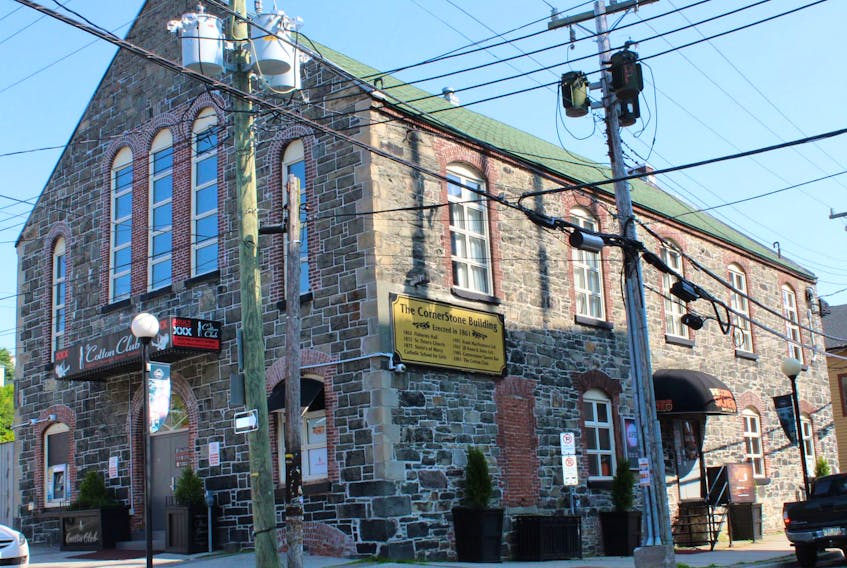ST. JOHN'S, N.L. — Bob Thorne unfolds a neatly typed, well preserved letter from 1952 — a blip in his employment life — but he still can take you on an imaginary tour through the office, where his clerk's desk was, where the salesmen sat, and lead you upstairs to the warehouse as if you could walk right in and order some bacon or produce.
“The bearer of this note Robert Thorne had been in our employ for the past seven months and during that time we found him a very obliging, honest employee,” reads the Feb. 19, 1952, note from Frank McNamara Ltd. “His only reason for leaving our firm is to seek more renumeration.”

But if you dropped down to 16 Queen St. in St. John’s, you’d find a very different kind of product.
“It was a good experience, but there was no future in that,” said Thorne, who has been retired since the late 1980s from the federal government.
“If I was up there now, what is it, a strip club? … I’m not into the George Street scene.”
McNamara Ltd. left the building long before it became a strip club, or a bar of any sort. And back in the 1950s — the landscape of George Street, which starts at Queen Street and runs down to Water — was more commercial enterprises like McNamara’s than the famed bar strip it is today.
Thorne contacted The Telegram after reading a feature on the former Evening Telegram building on Duckworth Street and some of its uses, which began with a garment factory.
In the case of the Corner Stone building — which dates to the 1860s — if those walls could talk, they’d blush so red, they’d make a beet look pale in comparison.
If you heard Jacqueline Cadorette’s story of trying to sleep in the building one night after getting locked out of her apartment, you might think the walls can indeed talk.
“It was really creepy,” Cadorette, operations manager of the Cotton Club strip bar and Corner Stone sports bar, said of the howling voices emanating from the empty upstairs, where the stripper pole rises from the stage to the vaulted ceiling.
It was long after closing time and staff had finished their night duties and gone home when Cadorette tried to settle down on one of the leather couches downstairs in the sports bar. She had to open the bar the next morning and got almost no sleep.
“It felt like something was there,” she said.
People joke about deceased nuns haunting the building, and strange noises are nothing new — many explained away by aging plumbing or the regular sounds of the basement cooler, the quirks of a building nearly 160 years old.
“I am a science person and I tell myself there’s a logical explanation,” said Cadorette.
Historic value
William Mullins can talk the gamut of subjects from politics, the state of the economy, the life of a musician on the road in the 1980s, as well as the uncleanliness of nearby bars in comparison to the pristine interior of the Corner Stone and Cotton Club — the first thing you smell walking in the door is cleaning supplies, and the bathrooms are said to be the cleanest on George Street.
They were indeed spotless on a Telegram visit.

Mullins also admits to having made up the story of the haunting nuns from more than a century ago, the lore being the pair are annoyed at their nearby graves being disturbed, a bit of fun to set the scene for staff inhabiting the historic stone structure that displays an exterior sign listing all of its previous uses, including Catholic girls’ school and church.
The Corner Stone is also the oldest surviving theatre in the city, according to the City of St. John’s archive.
“Sixteen Queen Street has historic value because it was built by the Fishermen's Society as a hall and exhibition centre for fisheries and agriculture produce, but it became an important venue for theatre, special performances and bazaars,” said archives technician Alanna Wicks.
The foundation meeting of the Star of the Sea was held in the building.
In 1872, ownership of the hall was transferred to the Roman Catholic Diocese of St. John's and the building was dedicated as St. Peter's Church. The upper floor was used as a church for Catholics awaiting the completion of St. Patrick's Church, and the ground floor held a school operated by the Sisters of Mercy.
From 1903-67, it was the office and warehouse space for Frank McNamara Ltd. JB Hand and Sons Ltd. took it over in 1967.
The Corner Stone bar, a popular dance club of the 1980s, moved in in 1985, and in 2001 the Cotton Club strip club moved upstairs.
Mullins used to play drums in bands in the dance club — a time when most spots on George Street had live music.
Tired of the musician’s life travelling around the province, he now cleans, sets up, controls the light show in the strip club and does general maintenance. He’s had to deal with every situation imaginable, including a guy who was trying to dye his hair black in the washroom. It was Halloween, and the dye made a ridiculous mess.
“It pays good. It’s either here or picking up recyclables,” he said.
The stone exterior of the building, the sign detailing its eclectic history and general look of a modest church-like exterior is an eye catcher for tourists and others uninitiated with the strip club culture.
Many photos are taken of the exterior, and families often walk in, to be warned that the only washroom — which the robe-clad-only strippers use — is on the main floor, so not appropriate for children.
“‘Oh, oh,’ it’s a strip club,'” they say, recounts Cadorette of some of the reaction.
The bars lease the space from private owners, but have to adhere to heritage zone rules, so certain renovations to the building can be costly and time consuming, said Cadorette, noting there can be numerous redesigns requested for planned changes.
For instance, they had hoped to put air conditioning in the upstairs, which can boil in summer. Business, however, in the strip bar industry is not what it once was and the cost was in the tens of thousands, a hard price for a few weeks in the summer of up and down Newfoundland weather.
Like many sectors, strip clubs have been hit by the ready availability of just about everything with the click of a mouse.
Those inclined for private, in-home bachelor parties and such can order a girl just like a pizza, Cadorette said of the plethora of exotic dancing websites on the internet.
Then there’s the economy — which in the oil boom days of St. John’s used to see Fort Mac commuters head straight from the airport to the bar strip. It was not uncommon for a guy to drop a few thousand on such an outing on tips, lap dances, and other bump and grind services, and the ATM to be emptied of tens of thousands by the end of each night.
Preserving heritage
Shannie Duff has never set foot in the strip club, but she was an early advocate of saving the structure.
In the early 1970s, Duff, now retired from St. John’s city council and a heritage preservation pioneer, detailed its history for the Trident, the newsletter for the historic trust.
At the time, the building was empty and in danger of destruction, Duff recalled.
The whole of downtown St. John’s was in decline as shopping malls lured the public away. The hoped-for reuses of the Corner Stone back then were way ahead of their time and included a Beaton Sheppard architect’s sketch showing themed venues that would celebrate its heritage, such as a fish and produce market, as well as a small theatre and craft workshop.
The article noted the tourist potential of being nearby the then brand-new St. John’s City Hall. The lobby to preserve 16 Queen St. was on the cusp of the resurgence of the downtown and the ramping up of heritage preservation. The Newfoundland and Labrador Heritage Foundation went on to secure $500,000 in funding from the Devonian Group of Charitable Foundations, with matching grants from the province, Duff said.
Over the next five years, the trust renovated 23 downtown buildings and reinvested the money in the fund. They paid $7,000 to $10,000 for each house, she said.
“There were 40 empty buildings with doors hanging open in the downtown,” she said.

“Demolitions were happening hand over fist.”
Federal programs that fixed infrastructure was also a major boost for the historic resurgence.
But the advocates' vision for the Corner Stone never saw the light, as the eventual owners went in a different direction.
It was an adaptive reuse, a bit more respectful of the original,” Duff said of the trust’s concept.
“We did not envision a strip club,” she said.
“At least they didn’t tear it down.”
Got an interesting story about an old building? Contact Barb Sweet.
Twitter: @BarbSweetTweets









